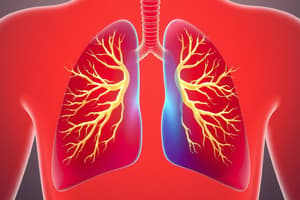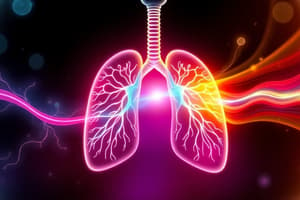Podcast
Questions and Answers
What is the main function of gas exchange in organisms?
What is the main function of gas exchange in organisms?
- To obtain important gases and remove waste gases (correct)
- To synthesize proteins
- To produce energy through metabolic reactions
- To regulate body temperature
What is the advantage of having a high surface area to volume ratio in gas exchange?
What is the advantage of having a high surface area to volume ratio in gas exchange?
- It relies on diffusion across the body surface (correct)
- It increases the distance for gas diffusion
- It reduces the rate of gas exchange
- It increases oxygen consumption
What is a characteristic of effective gas exchange surfaces?
What is a characteristic of effective gas exchange surfaces?
- Large surface area and permeability (correct)
- Small surface area
- Impermeable surface
- Thick tissue layer
What is the role of stomata in plants?
What is the role of stomata in plants?
What is the driving force behind gas diffusion?
What is the driving force behind gas diffusion?
What is the significance of a moist surface in gas exchange?
What is the significance of a moist surface in gas exchange?
What ensures the continuous exchange of gases in the lungs?
What ensures the continuous exchange of gases in the lungs?
What is the role of type I pneumocytes in the lungs?
What is the role of type I pneumocytes in the lungs?
What happens to the pressure in the lungs during inhalation?
What happens to the pressure in the lungs during inhalation?
What happens to the diaphragm during inspiration?
What happens to the diaphragm during inspiration?
What happens to the external intercostal muscles during quiet breathing?
What happens to the external intercostal muscles during quiet breathing?
What happens to the volume of the thoracic cavity during exhalation?
What happens to the volume of the thoracic cavity during exhalation?
What happens to the internal intercostal muscles during inspiration?
What happens to the internal intercostal muscles during inspiration?
What happens to the air during forced exhalation?
What happens to the air during forced exhalation?
What is the primary function of the nasal cavity?
What is the primary function of the nasal cavity?
What is the purpose of the epiglottis?
What is the purpose of the epiglottis?
What is the function of the diaphragm?
What is the function of the diaphragm?
What is the purpose of the bronchiole network?
What is the purpose of the bronchiole network?
What is the function of the trachea?
What is the function of the trachea?
What is the purpose of the alveoli?
What is the purpose of the alveoli?
What is the function of surfactant in the alveoli?
What is the function of surfactant in the alveoli?
What is the process called that includes both inspiration and expiration?
What is the process called that includes both inspiration and expiration?
Flashcards are hidden until you start studying
Study Notes
Gas Exchange
- Allows organisms to obtain important gases and remove waste gases produced in metabolic reactions through diffusion
- Organisms with a high surface area to volume ratio rely on diffusion across body surface to obtain and release gases
- Specialized structures like lungs with highly folded branched surfaces have evolved in larger organisms to exchange gases
Properties of Effective Gas Exchange Surfaces
- Large surface area provides more membrane space for gases to diffuse across
- Permeability: exchange surface must have pores or openings that allow gas exchange
- Thin tissue layer reduces the distance gases need to move
- Moist surface helps dissolve gases before diffusing across exchange surface
Concentration Gradient
- Diffusion occurs through a difference in concentration of gas between two areas
- Gas moves from higher to lower concentration
- Continuous blood flow helps maintain a concentration gradient
Ventilation
- Ensures air or water with the desired gas is moved across the exchange surface
- In mammals, lungs are responsible for gas exchange between air and bloodstream
Lungs
- Alveolar fluid surfactant moistens the surface of the alveoli, allowing gases to dissolve
- Type I pneumocytes secrete alveolar fluid containing surfactant, a mixture of lipids and proteins
- Bronchiole network: each bronchiole branches into many alveoli, creating a larger surface area for gas exchange
- Alveoli: tiny sacs where CO2 and O2 are exchanged between air and blood
Respiratory System
- Nasal cavity: filters air, warms it, and allows air to enter the respiratory system
- Buccal cavity: allows passage of air into the trachea
- Pharynx: the throat is the passage which air travels from the mouth and nose into the trachea
- Epiglottis: a flap of cartilage that covers the trachea when swallowing, preventing food from entering the trachea
- Larynx: the voice box, a hollow tube that lets air pass from the pharynx to the trachea, containing vocal cords
- Trachea: the windpipe, an airway that carries air into the lungs, with C-shaped cartilaginous rings for structural strength
Ventilation Process
- Includes both inspiration and expiration
- Involves the diaphragm, intercostal muscles, and abdominal muscles
Breathing Mechanism
- Inspiration: diaphragm contracts, external intercostal muscles contract, and internal intercostal muscles relax, increasing the volume of the thoracic cavity and decreasing pressure, allowing air to rush into the lungs
- Expiration (quiet breathing): diaphragm relaxes, external intercostal muscles relax, and internal intercostal muscles contract, decreasing the volume of the thoracic cavity and increasing pressure, pushing air out of the lungs
- Forced expiration: diaphragm relaxes, external intercostal muscles relax, and internal intercostal muscles contract, forcefully decreasing the volume of the thoracic cavity and increasing pressure, pushing air out of the lungs
Studying That Suits You
Use AI to generate personalized quizzes and flashcards to suit your learning preferences.




